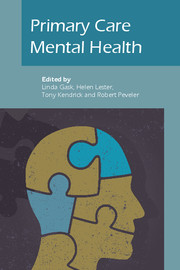Book contents
- Frontmatter
- Contents
- List of figures, tables and boxes
- List of contributors
- Preface
- Part I Conceptual basis and overarching themes
- Part II Clinical issues
- 8 Depression
- 9 Suicide and self-harm
- 10 Anxiety
- 11 Medically unexplained symptoms
- 12 Mental health problems in older people
- 13 Perinatal mental health
- 14 Child and adolescent mental health
- 15 Psychosis
- 16 Emergencies in primary care
- 17 Substance misuse
- 18 Management of alcohol problems
- 19 Eating disorders
- 20 Physical health of people with mental illness
- 21 Ethnic minorities
- 22 Asylum seekers and refugees
- 23 Sexual problems
- Part III Policy and practice
- Part IV Reflective practice
- Epilogue: Racing pigeons and rolling rocks: reflections on complex problems in primary care
- Index
14 - Child and adolescent mental health
from Part II - Clinical issues
Published online by Cambridge University Press: 02 January 2018
- Frontmatter
- Contents
- List of figures, tables and boxes
- List of contributors
- Preface
- Part I Conceptual basis and overarching themes
- Part II Clinical issues
- 8 Depression
- 9 Suicide and self-harm
- 10 Anxiety
- 11 Medically unexplained symptoms
- 12 Mental health problems in older people
- 13 Perinatal mental health
- 14 Child and adolescent mental health
- 15 Psychosis
- 16 Emergencies in primary care
- 17 Substance misuse
- 18 Management of alcohol problems
- 19 Eating disorders
- 20 Physical health of people with mental illness
- 21 Ethnic minorities
- 22 Asylum seekers and refugees
- 23 Sexual problems
- Part III Policy and practice
- Part IV Reflective practice
- Epilogue: Racing pigeons and rolling rocks: reflections on complex problems in primary care
- Index
Summary
Epidemiological research has shown that mental health problems and psychiatric disorder are common in childhood and adolescence. They are associated with suffering and impairment, and continue into adult life. Even in countries where specialist child and adolescent mental health services have been developed, access remains a problem owing to scarcity of resources. As evidence for the effectiveness of some interventions accumulates, the role of primary healthcare in child and adolescent mental health is evolving.
Common presentations and epidemiology
Many children and adolescents, particularly in higher-income countries, have regular contact with primary healthcare services. Within the UK, over 90% of pre-school children and about two-thirds of 5- to 14-yearolds will consult primary care at least once a year (Office of Population Censuses and Surveys, 1995). Over 50% of 13- to 17-year-olds registered with a large London inner-city practice attended in 1 year (Kramer et al, 1997) and comparable results are reported in other countries (Veit et al, 1995; Frankenfield et al, 2000). When primary care services are already in contact with young people, there is a clear opportunity for such services to be involved in addressing mental health.
Surveys across countries have documented that the majority of children and adolescents present to primary care with overtly physical complaints. Only 2–10% of those attending present primarily for psychological problems, for example anxiety, behavioural problems, overactivity, educational or social problems (Jacobson et al 1980; Starfield et al, 1980; Garralda & Bailey, 1986, 1989; Kramer & Garralda, 1998). Despite low levels of emotional or behavioural presentations in attenders, research interviews have demonstrated psychiatric disorders in one-tenth to one-quarter (Giel et al, 1981; Garralda & Bailey, 1986; Costello et al, 1988; Gureje et al, 1994), with higher rates in adolescents (40%) (Kramer & Garralda, 1998) and in schoolchildren attending hospital paediatric out-patient departments (28%) (Garralda & Bailey, 1989). In contrast to population surveys, emotional disorders predominate over conduct disorders (Garralda & Bailey, 1986: Kramer & Garralda, 1998), suggesting a specific role for primary care in identifying and managing anxiety and depressive disorders. The relatively increased rates of psychiatric disorders in attenders in relation to community surveys, in conjunction with increased primary care use among those with a disorder (Offord et al, 1987; Monck et al, 1994; Lavigne et al, 1998), suggest that the presence of psychiatric disorder increases the likelihood of attendance with somatic complaints.
- Type
- Chapter
- Information
- Primary Care Mental Health , pp. 211 - 231Publisher: Royal College of PsychiatristsPrint publication year: 2009



